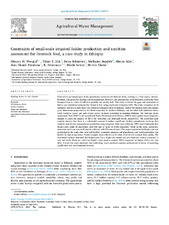Constraints of small-scale irrigated fodder production and nutrition assessment for livestock feed, a case study in Ethiopia
Abstract
Livestock is an integral part of the agricultural system in sub-Saharan Africa, serving as a food source, income, fertilizer, and power for farming and transportation. However, the productivity of the livestock system has been hampered due to a lack of sufficient quantity and quality feed. This study evaluates the gaps and constraints of fodder and nutritional potential for livestock feed using small-scale irrigation (SSI). The study comprised of 30 randomly selected farmers from two different ecological zones in Ethiopia. Half of the farmers cultivated Napier grass (Pennisetum purpureum) in the Robit watershed in northern Ethiopia, and the other half cultivated mixed vetch (Lathyrus cicera) and oats (Avena sativa) in Lemo watershed in southern Ethiopia. The Soil and Water Assessment Tool (SWAT) and Agricultural Policy Environmental eXtender (APEX) were applied in an integrated manner to assess the impacts of SSI at the watershed and field-scale levels, respectively. The watershed-scale analysis showed that there is a substantial amount of surface runoff and shallow groundwater recharge that could be used for dry season fodder production using irrigation. Field data calibrated APEX model indicated that Napier yield could be maximized with 550 mm of water in Robit watershed. While in the Lemo watershed, maximum vetch and oats yield may be achieved with 250 mm of water. The major constraints for Napier and oats production in the study sites were soil fertility, especially nitrogen and phosphorus, and vetch production was limited by high temperature. Fodder samples were collected at the time of harvest to evaluate feed quality. The nutritional analysis indicated that Napier grass has a higher dry matter and ash (mineral) content compared to oats and vetch. However, vetch has higher crude protein content (18%) compared to Napier (10%) and oats (6%). Overall the study indicated that cultivating vetch provided superior performance in terms of providing quality feed and environmental services.


